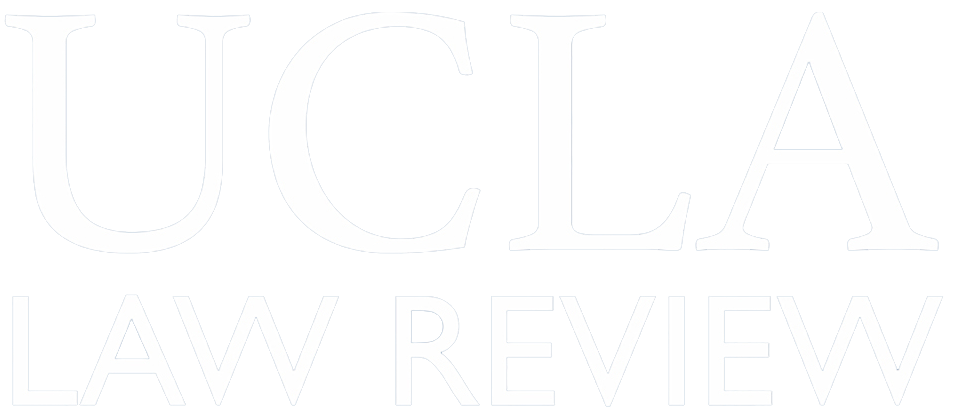Tribal sovereignty suffered greatly by the 1953 passage of Public Law 280, which gave certain states jurisdiction over the Indian country within their borders. However, recent cases show that tribes can preempt this state jurisdiction, and thereby reclaim some measure of sovereignty, if they prose¬cute crimes first—so long as the surrounding state has a statute abrogating the dual sovereignty...
Employing Ex-Offenders: Shifting the Evaluation of Workplace Risks and Opportunities From Employers to Corrections
Employers would just as soon not hire ex-offenders. They see the potential for workplace violence or theft, negligent hiring liability, and public relations nightmares. Because current law places the burden on employers to evaluate the risk that a particular ex-offender poses on the job, but gives them few tools with which to make that evaluation, employers would rather err on the side of caution...
Can Regulation Evolve? Lessons From a Study in Maladaptive Management
In the active literature on regulatory reinvention, many have pointed to the Habitat Conservation Plan (HCP) program of the Endangered Species Act (ESA) as a successful example of the potential for collaborative and experimentalist regulatory innovation. Yet, despite its frequent mention as a prototype for fostering public participation and adaptive decisionmaking, no thorough, systematic...
The Internet and the Project of Communications Law
The Internet offers the potential for economic growth stemming from online human communications. But recent industry and government actions have disfavored these possibilities by treating the Internet like a content-delivery supply chain. This Article recommends that the Internet be at the center of communications policy. It criticizes the nearly exclusive focus of communications policy on the...
Tied Up in Knotts? GPS Technology and the Fourth Amendment
Judicial and scholarly assessment of emerging technology seems poised to drive the Fourth Amendment down one of three paths. The first would simply relegate the amendment to a footnote in history books by limiting its reach to harms that the framers specifically envisioned. A modified version of this first approach would dispense with expansive constitutional notions of privacy and replace them...
Overworking the Presumption of Sanity: Clark's Use of Mental Disease Evidence to Negate Mens Rea
The presumption of sanity is a concept in criminal law used to allocate burdens relating to the insanity defense. In Clark v. Arizona, the U.S. Supreme Court relied on the presumption to affirm the exclusion of evidence introduced to negate mens rea. This Comment discusses the problems with using the presump¬tion to exclude evidence from mens rea determinations and examines other ways to regulate...
When Should We Permit Differential Pricing of Information?
Each year, the UCLA School of Law hosts the Melville B. Nimmer Memorial Lecture. Since 1986, the lecture series has served as a forum for leading scholars in the fields of copyright and First Amendment law. In recent years, the lecture has been presented by such distinguished scholars as Lawrence Lessig, Robert Post, Mark Rose, Kathleen Sullivan, David Nimmer, and Jonathan Varat. The UCLA Law...
Does Analyst Independence Sell Investors Short?
Regulators responded to the analyst scandals of the late 1990s by imposing extensive new rules on the research industry. These rules include a requirement forcing financial firms to separate investment banking operations from research. Regulators argued, with questionable empirical support, that the reforms were necessary to eliminate analyst conflicts of interest and ensure the integrity of sell...
The Liberties of Equal Citizens: Groups and the Due Process Clause
When the U.S. Supreme Court, in Lawrence v. Texas, struck down a law criminalizing homosexual sodomy, its decision was seen by the press and other political observers as a major contribution to American public life. The Court’s opinion also caught the attention of commentators on constitutional law, for it drew on the theme of equal citizenship to justify a decision resting on substantive due...
Legal Realism in Action: Indirect Copyright Liability's Continuing Tort Framework and Sony's De Facto Demise
The U.S. Supreme Court’s indirect copyright liability standard, derived in Sony Corp. of America v. Universal City Studios, Inc. from patent law and reasserted in Metro-Goldwyn- Mayer Studios Inc. v. Grokster, Ltd., is widely seen as creating a safe harbor for distributors of dual-use technologies. Yet, when one looks to cases decided since Sony, subsequent legislative enactments, and post-Sony...
Dysfunctional Equivalence: The New Approach to Defining "Postal Channels" Under the Hague Service Convention
In recent years, article 10(a) of the Hague Service Convention, which allows for the sending of judicial and extrajudicial documents abroad by postal channels, has proven difficult to apply in the face of commercial and techno¬logical change. The difficulties stem from the fact that the Convention neglects to define the term “postal channels.” In 2006, the Permanent Bureau of the Hague Conference...
The Path to Recognition of Same-Sex Marriage: Reconciling the Inconsistencies Between Marriage and Adoption Cases
Only five years ago, same-sex marriage was not legal anywhere in the United States. That changed in November 2003, when the Supreme Judicial Court of Massachusetts held in Goodridge v. Department of Health that the state may not deny the protections, benefits, and obligations conferred by marriage to two individuals of the same sex who wish to marry. Advocates of same-sex marriage hoped that the...
Institutions as Legal and Constitutional Categories
Institutions and institutional categories pervade the world and pervade human thinking, but institutional categorization plays a smaller role in constitutional doctrine than might be expected. Although constitutional doctrine often uses categories of the law’s own making, and often draws distinctions based on the character of the act or (less frequently) the character of the agent who engages in...
The Solomon Amendment, Expressive Associations, and Public Employment
Employment law commentators have paid insufficient attention to the Solomon Amendment case of Rumsfeld v. Forum for Academic & Institu¬tional Rights, Inc. (FAIR) and its discussion of the right to expressive association under the First Amendment. By failing to methodically analyze whether all law school constituents of the FAIR organization constitute expressive associations, the Court...
